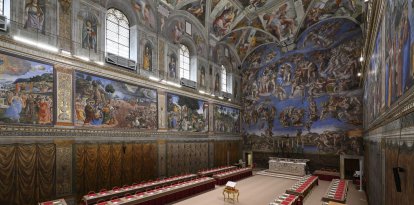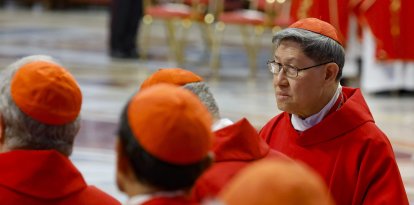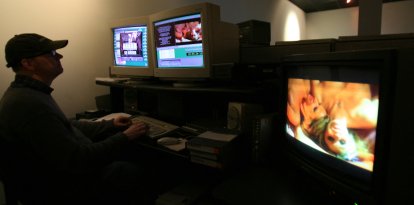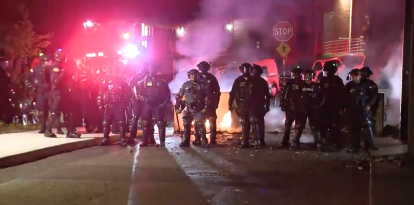The key places of the conclave: from St. Peter's Basilica to the Sistine Chapel
Within a maximum of 20 days, the cardinals will convene to choose Pope Francis’ successor through a series of rigorously observed ceremonies.
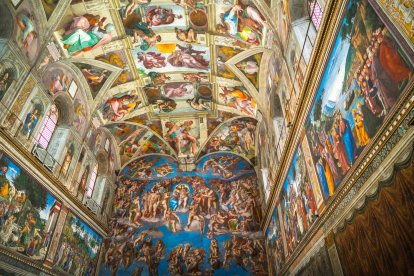
Image of the dome of the Sistine Chapel, in the Vatican.
The conclave, which in the coming weeks must elect the successor of Pope Francis, follows to the letter a very precise protocol drawn up over centuries in several places steeped in history.
These are the main ones:
BASILICA OF ST. PETER: Under the gilded moldings and precious marbles of this basilica, the cardinals gather to celebrate the Mass that begins the process of electing the pope. After the service, the cardinal electors move in procession to the Sistine Chapel, singing the "Veni Creator."
In St. Peter's Basilica the conclave also officially ends, with the proclamation of the new pope ("Habemus papam!") from the loggia of the temple.
It is the largest church in the world, with an area of 2.3 hectares, the work of architects such as Bramante, Michelangelo and Bernini, which was built between 1506 and 1626.
SIXTH SISTINE CHAPEL: Built between 1477 and 1480, the Sistine Chapel is located on the right flank of St. Peter's Basilica, within the precincts of the Apostolic Palace. It was erected at the request of Pope Sixtus IV and apparently has exactly the same measurements (40.5 meters long, 13.2 m wide and 20.7 m high) as the legendary temple of King Solomon.
This place is known for its frescoes, works by Perugino, Botticelli and his pupils, and, above all, for its vault, made by Michelangelo, who also painted the famous 'Last Judgment' on the wall in front of the entrance, just behind the altar.
During the conclave, the cardinals sit on cherry wood chairs with their names engraved on them, in front of tables covered with beige and maroon tablecloths. At the back is an urn with the lid adorned with two figures representing lambs, in which the ballots are deposited.
In the center, there is a lectern with an open Gospel before which the cardinals swear to maintain the secrecy of what is said there.
The chapel has two stoves connected to the same chimney from which comes the only indication of what is happening inside.
In one stove, the older one, the ballots and the notes of the cardinals are burned. The other, more modern, serves to announce the result of the voting. From the latter, with the help of chemicals, black smoke comes out (if the cardinals do not reach an agreement) or white, when a new pope has been elected.
HALL OF TEARS: At the back of the Sistine Chapel there is a door that communicates with a small cell of 9 square meters, permanently closed to the public. It is the so-called "Room of Tears," where each new pope, after being elected, enters accompanied by the cardinal camarlengo (in charge of Vatican affairs during the transition between two papacies) and the master of liturgical ceremonies to, according to tradition, break into tears at the magnitude of the task that awaits him and wear his first white cassock, with which he will be presented to the world.
Pauline Chapel: After being elected, and before entering the loggia of St. Peter's for his first public appearance, the new pope prays a brief, personal and silent prayer in front of the Blessed Sacrament. Built in 1537 by the architect Antonio da Sangallo the Younger at the request of Pope Paul III, this chapel is located near the Sistine Chapel and St. Peter's Basilica.
RESIDENCE OF SANTA MARTA: Cardinal electors are housed in the residence of Santa Marta, built under the pontificate of John Paul II, just behind the basilica. Previously, the cardinals were housed in uncomfortable, makeshift rooms in the Apostolic Palace. In this residence, which also includes a chapel, each cardinal has a room and hotel-like services (meals and laundry).
Each morning, the cardinals leave the residence and walk or take a minibus to the Sistine Chapel, 500 meters away.
In general, the bedrooms have a single bed with a crucifix above the headboard. Most are suites with an adjoining room equipped with a desk and a telephone connected only to the internal network. Not all rooms are equally comfortable and are distributed by lottery.
RESTRICTIONS: One rule governs unalterably during the conclave: from the moment it begins, the cardinals swear to keep everything that happens in secret, under penalty of excommunication. Any contact with the outside, whether through telephones, internet or newspapers, is strictly forbidden, except in very exceptional cases.
All places where cardinals live and work are covered by jamming devices that prevent the use of phones and tablets. In addition, while the cardinals walk from the Santa Marta residence to the Sistine Chapel, the circulation of vehicles and pedestrians is interrupted to prevent any contact.
All personnel working at the conclave sites, such as drivers, cooks, receptionists, cleaners, nurses or doctors, also promise to keep silent, in a solemn ceremony.
RECOMMENDATION



